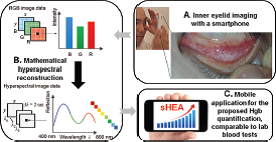Spectrometerless Smartphone Anemia Diagnosis
Purdue Collaborator: Weldon School of Biomedical Engineering; Regenstrief Center for Healthcare Engineering
The Challenge:
In developing countries, anemia is a major public health problem.3 WHO estimated that anemia affects 24.8% of the global population, corresponding to 1.62 billion people. In Africa, the prevalence of anemia is extremely high, affecting two thirds of preschool-age children and a half of women. For example, Kenya has reported anemia prevalence as high as 69% in preschool-age children and 51% in pregnant women, in part due to nutritional deficiency, malaria, and HIV infection. When anemia is not detected and managed in a timely manner, it can result in major health consequences, including fatigue, heart failure, pregnancy disorders and poor physical/cognitive conditions. Anemia is determined by the amount of hemoglobin (Hgb) in the blood. Thus, the gold standard and most common way of diagnosing anemia is a laboratory serum Hgb test that measures the Hgb level in the liquid part of the blood (i.e. serum).8, 9 Common Hgb-related blood tests cost ~ $5 in Kenya10 ($100 - $3,000 depending on insurance in the US). Given that a number of Kenyan individuals with anemia was 4,089,000 in 2006,4 the direct financial burden can be estimated to be ~ $200 million per year only in Kenya.
The Purdue Innovation
The fully functional mobile app of sHEA will be ready for noninvasive determination of Hgb levels. The clinical test will also allow us to refine the Hgb algorithm for the performance improvement of sHEA. ii) This project will serve as a model setting to tailor our technology for other resource-limited countries. iii) This work will provide a foundation for other grant opportunities, in particular “NIH Mobile Health: technology and outcomes in low and middle income countries (PAR-16-292) to comprehensively evaluate a larger patient population with a broader set of conditions (e.g. bilirubin assessments). In the diagram to below, A. Hgb microvasculatures exposed on the tissue surface of the inner eyelid can easily be imaged with a built-in camera in a smartphone, B. Reconstruction of hyperspectral images (λ = 400 – 800 nm with Δλ = 2 nm) from RGB images1, 2 is critical to be comparable to lab-based serum Hgb tests (definitive diagnosis of anemia as the gold standard), C. sHEA could further be integrated with an existing electronic health record (EHR) system in Kenya.

The Partners
Purdue University, Moi University Teaching and Referral Hospital in Kenya
Investigator Names
- Young Kim (PI, BME), Md.
- Munirul Haque (Co-PI, RCHE)
- Martin Were, MD, Vanderbilt University (Co-PI)
